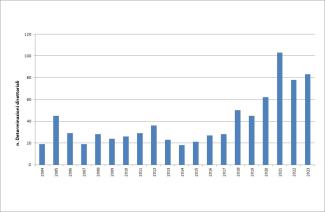Panel 1
Anna Cacciuni, Caterina D'Anna
The indicator represents the number of director’s determinations for Environmental Impact Assessment (EIA) Screening issued annually by MASE under state jurisdiction, providing insight into the central public administration’s response regarding environmental assessment decision-making processes.
From 2004 to 2023, there were 626 determinations of non-subjection to EIA and 148 determinations requiring EIA.
The screening procedure concluded with a determination of non-subjection in 79% of cases.
The indicator represents the number of director’s determinations for EIA Screening under state jurisdiction, issued annually by MASE.
To provide the response of the central public administration regarding decision-making processes related to environmental assessments.
- Legislative Decree 152/2006 and subsequent amendments
- Legislative Decree No. 104 of 2017
- Decree Law 34/2020 converted into Law 77/2020
- Decree Law 76/2020 converted into Law 120/2020
- Decree Law 77/2021 (Simplification Decree), converted into Law No. 108 of 29 July 2021
- Decree Law 92/2021 (Urgent measures to strengthen the Ministry for Ecological Transition and on sport)
- Law No. 25 of 2022
- Law No. 91 of 2022
- Law No. 6 of 2023
- Decree Law No. 13 of 2023
Panel 2
-
-
Data quality assessment
MASE – Ministry of Environment and Energy Security
National
2004-2023
Indicator assessment
Director’s determinations for EIA Screening under state jurisdiction, issued annually by MASE, were collected and analyzed. Starting from the determinations published on the MASE website, data were processed regarding the total number of non-subjection determinations, subjection determinations, and archived cases per year.
In 2021, 2022, and 2023, a total of 207 determinations of non-subjection to EIA were issued, while 55 determinations required subjection to EIA (Table 1).
An increase in the number of screening determinations for non-subjection to EIA has been observed over the last three years, indicating growing attention to sustainable and economic development in the country.
From 2004 to 2023, a total of 793 EIA screening procedures were examined: 626 determinations concluded with non-subjection to EIA, while 148 were determinations of subjection to EIA (Table 1 and Figure 1).
The types of projects subject to EIA screening under state jurisdiction have changed over time, in line with European directives and national legislation.
However, from 2018 to 2023, there has been a noticeable increase in the number of director’s determinations, consistently above the average for the entire 19-year period (2004–2023).
This growth confirms a greater awareness of environmental issues.
Data
Table 1: Total number of screening decisions for EIA at the national level (not subject to EIA, subject to EIA, and archived)
ISPRA processing based on MASE data
1 Positive and partially positive screening decisions (not subject to EIA) are considered until 2017. Since the entry into force of Legislative Decree 104/2017, “partially positive” decisions no longer exist.
Table 2: Number of screening decisions for EIA (not subject to EIA) by project type
ISPRA processing based on MASE data
a No longer subject to national procedure since the entry into force of Legislative Decree 4/2008



The information “number of determinations by project type” allows for identification of which and how many projects were subject to screening and resulted in a decision of non-subjection to EIA.
From 2004 to 2023, 79% of screening procedures concluded with a determination of non-subjection to EIA.
The classification adopted for project types (Table 2) refers to the categories listed in Annexes II and II-bis of Legislative Decree 152/2006 and subsequent amendments, in line with the classification used for “EIA Decisions”.
The types of projects subject to screening have evolved over time in line with legislative adaptations to European directives.
With the amendments introduced by Legislative Decree 104/2017, Annexes II, III, and IV were extensively revised, expanding the scope of state jurisdiction to include projects previously under regional responsibility (mainly energy plants and infrastructure), and identifying new projects under Annex II-bis subject to state-level screening (Article 7-bis).
As of today:
Waste-related plants have not been subject to EIA screening since the entry into force of Legislative Decree 4/2008, which amended Part II of Legislative Decree 152/2006.
By project type, over the reference period, the following positive determinations (i.e. requiring EIA) for modification/expansion works were recorded:
Considering only the years 2020, 2021, 2022, and 2023: